ANALYSIS OF CURRENT
TOOLS:
By:
JOHN
KILLORAN
MIKE KLENC
MICHELLE WEDGE
Click Here:
TO VIEW PRESENTATION
Priceline.com is an
Internet Service Provider that provides services in the travel industry such as
airline tickets, hotel reservations, and car rentals. Now, they also provide other services
such as long distance service, home financing, and new car purchases. In the beginning, they started out
only providing travel services.
They engineered a new way of travel for many people. They call it a "demand collection
system". Consumers name their own
price for a variety of items on the website. Priceline.com negotiates and matches
consumer bids with sellers in the industry. This system collects consumer demand
information through the Internet site.
Consumers save money by being flexible with respect to brands, sellers,
and/or product features while sellers generate incremental revenue without
disrupting their existing distribution channels or retail pricing structures. Priceline.com,
a service provider Internet company, was founded in 1996. Two years later, they launched the first
"buyer-driven commerce' vehicle on the web. The popularity of this site in its
initial week resulted in more than one million visitors in the first week
alone. Further, this popularity has
not subsided. In fact, just last
year, the company sold 10,000 airline tickets within a 24-hour period (a company
record).
DSS Supporting Role & Management Decision Support:
Since Priceline.com is working with consumers and industry, it is essentially managing two different types of customers. The web site collects data from consumers. Priceline.com has industry knowledge about capacity and availabilities. For example, they provide worldwide itineraries for air travel. They have knowledge of seat, hotel room and rental car availabilities at any time. They know the pricing schedules and can negotiate lower prices for consumers using Priceline's web site because they provide customer information directly to the industry. After making a search for a customer bid, a match would result in a purchase and an e-mail directly back to the customer in the form of acceptance and confirmation of bids. On the back-end, Priceline.com provides a database of consumer demand; prices consumers are willing to pay, and consumer flexibility to various industries. The airline, hotel, and rental agencies, in turn, can use the information to aid in scheduling and resource planning, product improvement, maintenance planning, and new marketing strategies. In the end, Priceline.com provides a service that brings consumer information to the industry while getting a deal for its customers.
The User Interface
The web site at Priceline.com is easy to use. On the home page, select the needed service. Choose the links or use the tabs.


As an example, a family of 4 wants to take a trip to San Francisco. They will fly and rent a mid-size car at the airport. They will stay in a deluxe hotel in the Fisherman's Warf, Civic Center, or Downtown area. The first thing the family does is click on the airline link. The page asks the user to enter the departure and arrival cities, departure and return dates and the number of tickets. The family enters the information and clicks NEXT.

The next page prompts the user for the airports they would like to use. At the bottom of this page is where the family submits it's bid for the airline tickets. The bid submitted is per ticket.
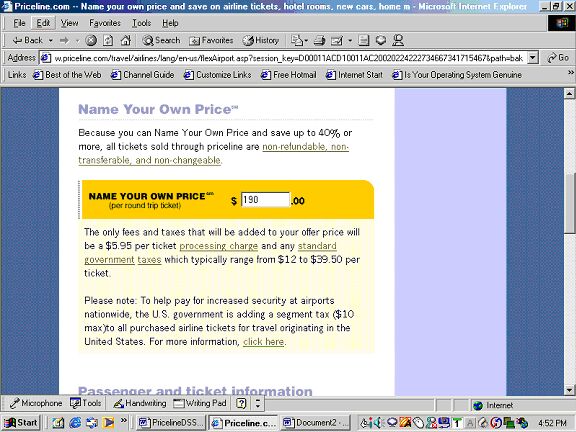
The family enters the bid. The page also explains that taxes and processing fees will be added to the amount submitted. Users also have the option to purchase travel insurance.
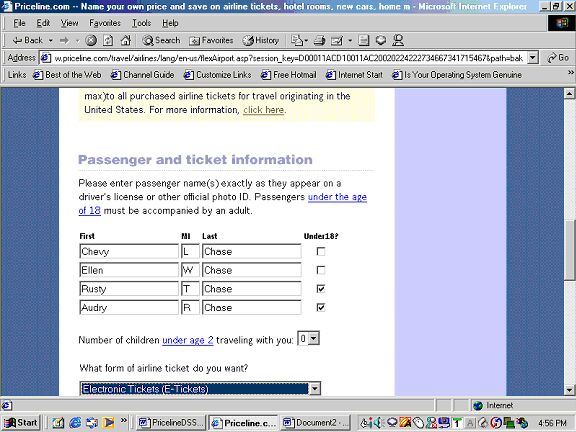
The user is asked to enter passenger information such as
passenger names and ages and if they would like to use E-tickets or paper
tickets. There is a charge for
sending paper tickets.
At the bottom of the page, the user is asked if he can be flexible on the dates he's traveling, the hours he travels and the number of connections he makes and if he is willing to fly on non-jet aircraft.
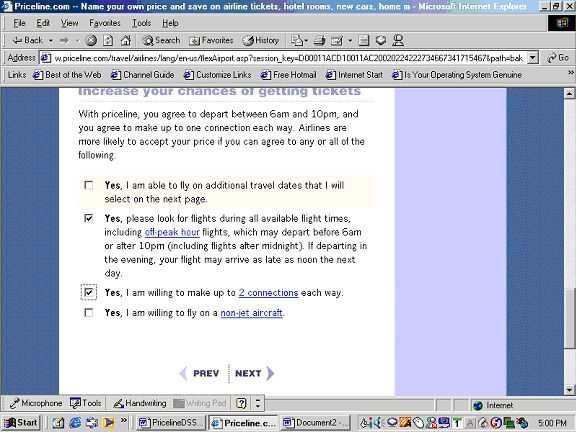
When NEXT is selected. The user gets a summary of his request.
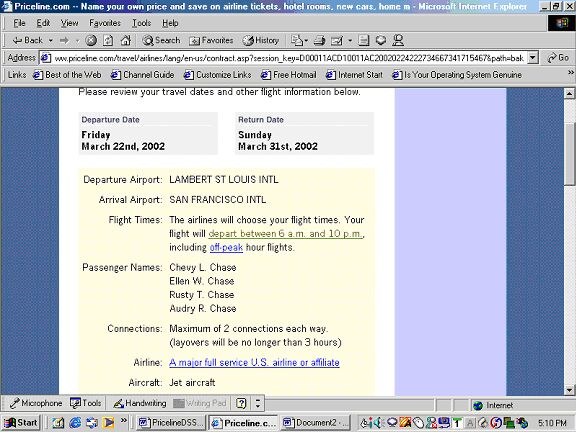

The user is given the conditions of the tickets. The tickets are round trip, coach class using a major full service US airline or affiliate. Tickets are non-refundable, non-transferable, and non-changeable. If user's price is accepted, tickets will be immediately purchased. Tickets are not eligible for frequent flyer miles or upgrades. Customers are protected by the usual airline regulations. Users are asked to initial to indicate review and agreement with the terms of the purchase.
The next page is a secure site where the user enters credit, billing and e-mail information.
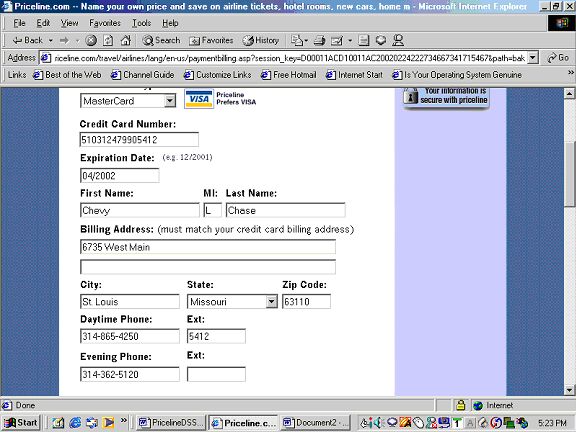
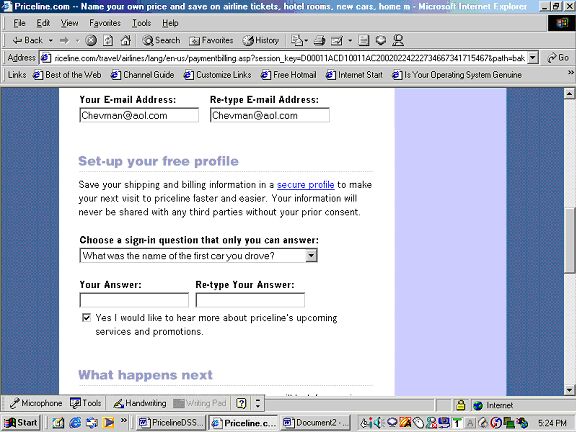
Priceline searches it's databases for a match of date, time, location and number of tickets and promises an answer in 15 minutes. If a match is found at the customer's bid price. The tickets are purchased and an E-mail is sent with the itinerary, final charge and confirmation number. If no match is found, Priceline sends an e-mail with suggestions about more suitable prices, dates, times, number of connections or aircraft choices. Customers can resubmit their bid one time to try again.
The hotel selection has a similar interface to the airline. The user enters the city name, check-in and check out dates and the number of rooms required. A map appears of the city and users are asked to choose the area they wish to stay. Users improve their chances by selecting 2 or more areas.
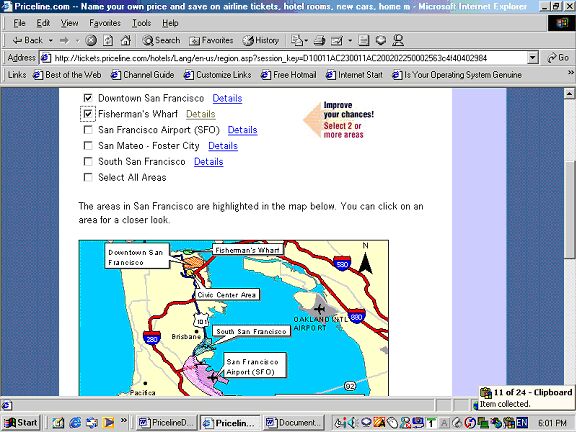
Users also must enter the quality level of the hotel they are seeking. They have 6 options (Economy, Moderate, Moderate Plus, Upscale, Boutique, and Deluxe) with a description for the user and an average retail price. They say they can save customers 40% on room rates.
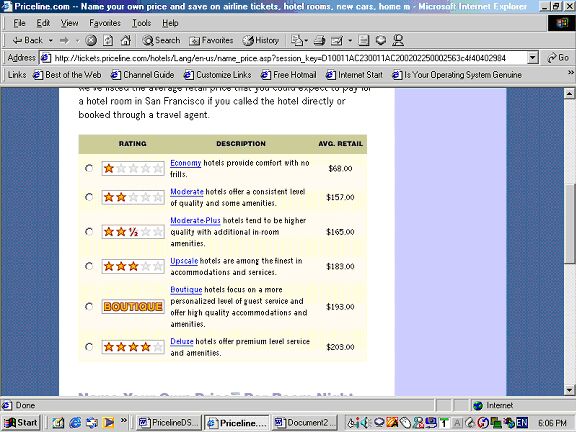
Users enter their bid and reservation information. They are instructed state and local taxes will apply. A summary page is displayed. Similar conditions are listed, in that, rooms are double occupancy, non-transferable, non-changeable, and cannot be cancelled. Rooms are not eligible for frequent traveler points, upgrades, vouchers, or other discounts. Initials are entered to signify review and agreement with the terms and conditions. Credit, billing and E-mail information is entered. Priceline searches it's databases for a match of date, time, location and number of rooms and promises an answer in 15 minutes. If a match is found at the customer's bid price. The rooms are purchased and an E-mail is sent with the Hotel Name, address and phone number, final price and confirmation number. If no match is found, Priceline sends an e-mail with suggestions about more suitable prices, dates, times, or quality. Customers can resubmit their bid one time to try again.
Car rental interfaces are also very similar. Users enter the pick-up/drop-off location, pick-up date and time, drop-off date and time, and type of car they need. There are 11 different types (Econo, Compact, Mid-size, Standard, Full, Premium, Luxury, Convertible, Mini-van, SUV, Compact pickup). A legend is provided with examples of cars makes, specific features in that group, and the number of people and luggage that can be accommodated. Users select the airport they are flying into and enter their flight number and driver information. A bid is entered, if the bid is too low, the user is prompted with suggestions that are 40%, 60% and 80% under retail price. A summary page and the conditions are listed. Changes, refunds and cancellations are not allowed unless the flight is cancelled. Insurance can purchased at the rental counter and a valid driver's license and credit card is required. Initials are entered to signify review and agreement with the terms and conditions. Credit, billing and E-mail information is entered. Priceline searches it's databases for a match of date, time, location and availability and promises an answer in 15 minutes. If a match is found at the customer's bid price. The rental is purchased and an E-mail is sent with the Rental Agency, address and phone number, final price and confirmation number. If no match is found, Priceline sends an e-mail with suggestions about more suitable prices, dates, times, or car selections. Customers can resubmit their bid one time to try again.
The Industry
Database
While the actual databases that Priceline has created or the specific corporate databases for each airline, hotel chain or car rental chain are kept confidential on the Priceline web site, it is clear that these companies are getting some specific and useful information from Priceline.
The airlines, for example, can find out the peak annual and daily service times that people like to travel. Because there are no frequent flyer miles, they are targeting infrequent travelers. Most likely, business travelers would not use this site. On pleasure trips, they can get some feel about how families plan trips. Are there more singles, doubles or groups traveling? By asking people if they would be willing to go on different dates, times, aircraft or have more connections, they are getting a feel of how much flexibility people are willing to give to get a discount.
The hotel chains also find out peak times people want to stay at their hotels. They get an idea about the number of people staying by the number of rooms purchased. By giving a map and asking people to choose two or more areas in which they would like to stay, they can gauge flexibility. In addition, by giving the average room rates in each category, people can calculate their price to be at least 40% lower than these prices. However, because room rates across the country vary as do room qualities from hotel to hotel, people who are more familiar with the area may be able to get a better hotel for a cheaper price. Those unfamiliar with the area would be taking their chances wherever they go and also would not be assured availability.
Rental agencies would also gain knowledge about annual peak usage times and to a smaller extent, about the number of people traveling from the size of vehicles requested. However, small numbers of people may want larger cars for the extra legroom. By asking the age of the driver and the driver's name (requirements for rental), they get some demographics about the people who rent.
Meeting the
Needs of Customers
It is fairly obvious how Priceline meets the needs of consumers who use their web site. If consumers type in exactly what they want, how much they are willing to spend, and show a little flexibility to get what they want for the right price, Priceline will try to match their request and take care of the reservations. Priceline is catering to consumer's motivations of getting the most for the least and wanting to spend only what they can afford. People who shop Priceline are probably one of two types of people. Those who are comparison shoppers and searched out the best deal on their own and want to see if Priceline can give them a better deal, or they are those who are lazy and trust that Priceline will be able to meet their demand.
Priceline also meets the needs of industry by helping them fill excess capacity. In a sense, Priceline is acting like an operations management scheduler for the travel industry for a certain area at a certain time. It spreads customers out by giving them flights, rooms and rentals at non-peak dates and times throughout a particular area. In this way, the entire travel industry benefits and everyone shares the wealth. By spreading people out at different times and dates, the travel industry is able to spread costs out more evenly in a very seasonal business. Knowledge of peak times also allows the industry to schedule flights, hotel and car usage, staff hotels and reservation desks, plan routine and long term maintenance on airplanes, rooms and cars. In addition, the various agencies can improve their products by offering more expensive meals on flights that are fuller, for example, where the dollars per person would be less. Marketing departments in the travel industry would have some valuable information about the groups of people who used Priceline. They could use the demographics and numbers of travelers to make additional offers to this segment to get them to use more services particularly at non-peak times.
Customer
Benefits
The four areas of benefits
for customers are convenience, flexibility, variety and
timely.
First, the DSS makes the decision making process of traveling very convenient for its customers. They are able to choose the airplane, hotel and car rentals all in one site. Next, the DSS provides flexibility for the consumer. When the demands of the consumer cannot be met, the system will offer hints on how to reach a more desirable price. For instance, it will provide a more accurate price range; suggest traveling during a different month, etc. Third, the system provides the consumer a wide range of choices. Consumers have the luxury of choosing an economical vacation to a very extravagant one. Last, the system provides results within fifteen minutes after the consumers request.
Vendor
Benefits
There are several benefits
to the vendors, but most importantly, the web site provides an alternative
channel to sell their services.
Moreover, the site actually attempts to sell the services during the
slower times of the year.
Therefore, the vendors can realize an increase in sales during non-peak
times. Second, the vendors can
essentially acquire a database that entails many demographical aspects of the
consumers. These demographics can
aid in their marketing strategies.
Priceline.com
Benefits
Obviously, the main benefit
to Priceline.com is the commission they receive for each of their sales. We can also assume that they are
collecting customer information for their own database. This database can be manipulated in a
number of ways: using it for their own personal use for marketing, selling the
information to other service providers, and/or allowing the vendors access to
it. Last, the company realizes
profits by having advertising banners appear on their site. Because of the massive number of
visitors each year, the site can provide advertisers a golden opportunity to
advertise their product them.
Drawbacks
Basically, consumers have trust that Priceline.com is giving them a discount for the concessions they are making. People usually have to be willing to make concessions in the first place to get a discount. People are led to believe that Priceline.com is not for frequent travelers because they do not offer frequent flyer miles or points at hotels and rental car agencies. This may not be true, however, if they are getting the same discount. Yet, discounts cannot be built up or saved for future use. People with special needs also would not be users of this site because special amenities are not guaranteed. For example, flights with meals are not guaranteed for those passengers who may be diabetic and need to eat during fight. Also, Priceline.com does not have relationships with all vendors. The vendors who do not have a relationship may be selling their services at a lower price. For example, Priceline.com customers cannot employ the services of Southwest Airlines. In the St. Louis market, this fact can pay a major role in the decision making process. Since Southwest has its own terminal in Lambert field, it is much easier and more convenient for customers to use their terminal
In conclusion, Priceline is meeting the needs of consumers as well as providing a service and information to the travel industry through the use of its web site. They are building customer relationships through people who have gotten a good deal. Those people will tell their friends and are likely to return. The travel industry gets valuable information about consumers of its products and they support Priceline by giving them knowledge of their schedules, excess capacities and pricing needs. From all sides, Priceline has created a win-win-win solution.